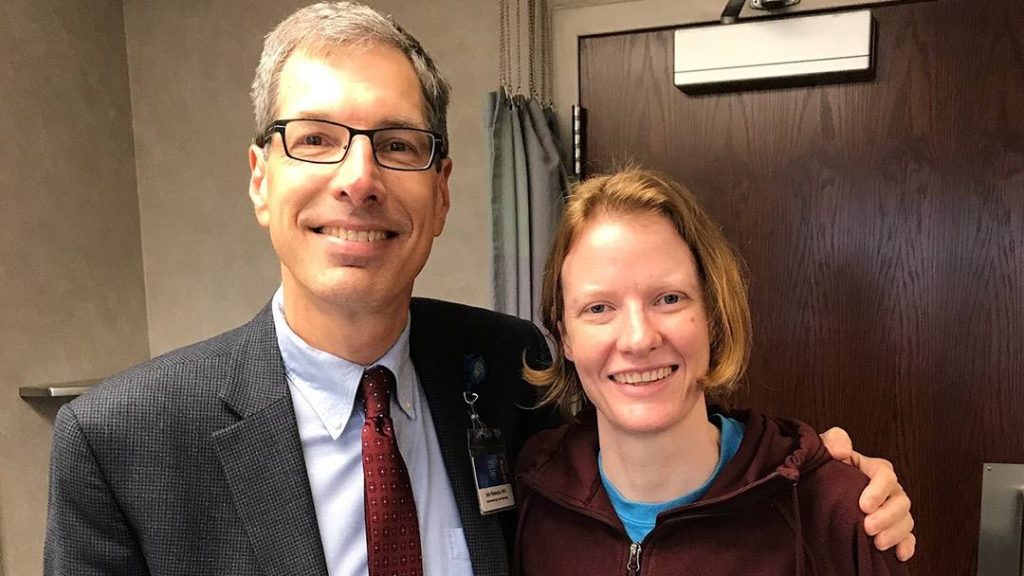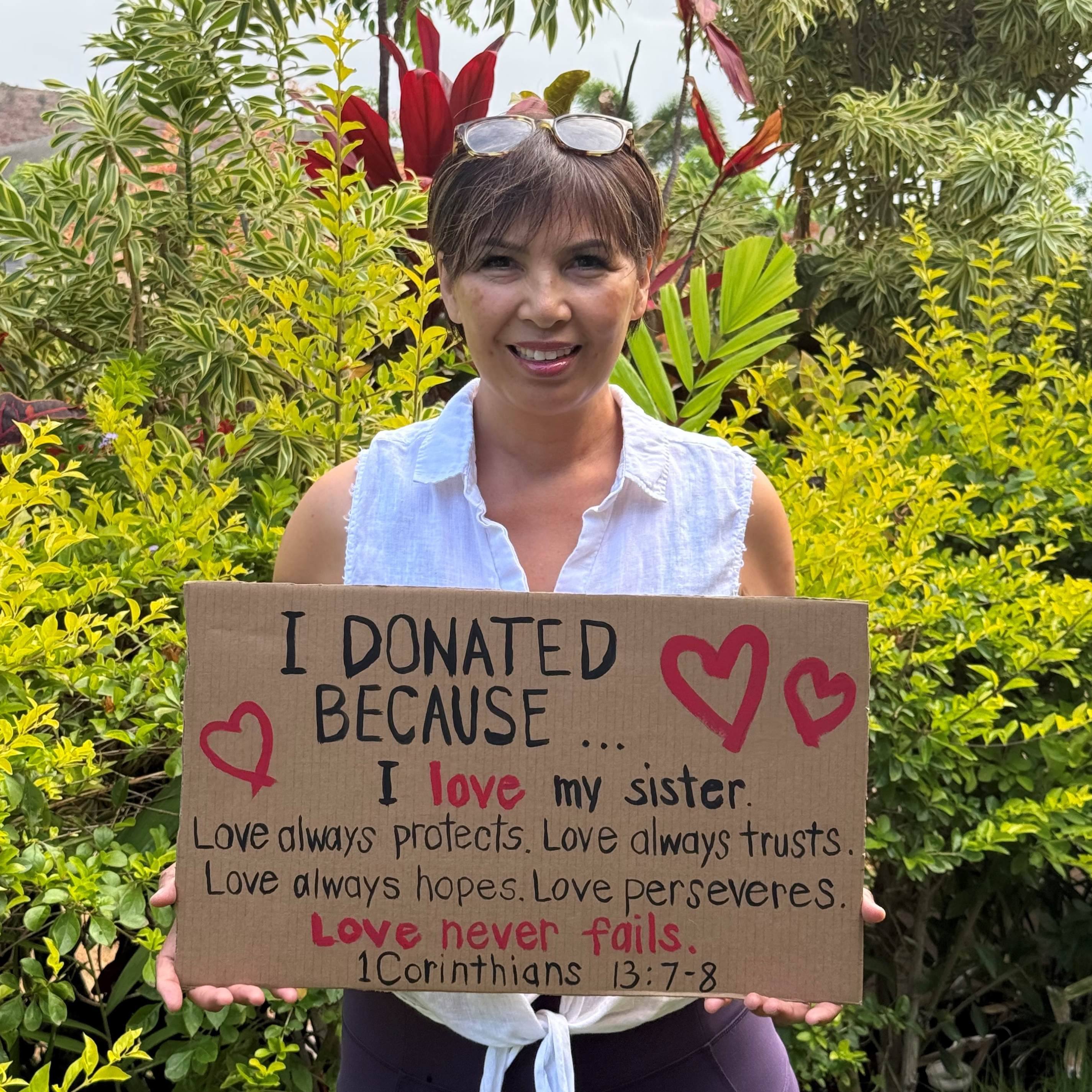
Collaboration among a multidisciplinary care team at Mayo Clinic helped Julianne Vasichek successfully navigate not one, but two, rare liver diseases.
After graduating from high school, Julianne Vasichek was eager to take her athletic talents to the women's hockey team at the University of Minnesota Duluth (UMD). Julianne's college career got off to a rocky start, however, due to a sudden change in her health. "I was symptomatic my entire freshman year of college while doctors tried to figure out what was going on," she says. "But I played through it."
Diagnosed with ulcerative colitis, Julianne had a colonoscopy done a week before the Bulldogs' 2001–02 NCAA Division 1 championship game. "That colonoscopy really helped spur me on during that game," Julianne says. "We did win, but I was pretty worn down by the end of the year from playing through my symptoms."
Doctors in Duluth, Minnesota, put Julianne on medication that kept her symptoms at bay long enough for her to finish her playing career at UMD. That career included another national title and tryouts for a spot on Team USA's women's ice hockey team. "I tried out for the 2006 Olympic team but didn't make the final cut," Julianne says.
After that, Julianne moved east to take an assistant women's hockey coaching job with Bowdoin College in Maine. "I was thinking about still trying to play hockey myself, but I started noticing throughout that year that I was just getting more and more tired," she says.
Initially chalking it up to being "tired from life in general," Julianne put her increased fatigue out of her mind. "I just shrugged it off," she says. Then at the start of 2008, her skin began to feel itchy. "I was in my early 20s and otherwise healthy, so again, I shrugged it off," she says.
When Julianne returned to Duluth a few weeks later to watch UMD host that year's national championship game, however, she couldn't ignore her symptoms any longer. "By that time, I was itching so badly I was cutting the skin around my ankles and feet," she says. "It was at that point that I said, 'Maybe I do need to get this checked out.'"
Facing a scary diagnosis
When Julianne got back to Maine, blood tests revealed a surprising cause for the itching. "I was diagnosed with primary sclerosing cholangitis," she says. "It's an inflammatory disease that causes scarring within my bile ducts that, in turn, makes the ducts hard and narrow. Over time, it causes serious liver damage."
Julianne was told the damage eventually would require a liver transplant. "That was a scary thing to hear," she says. "But my gastroenterology doctor in Maine said the disease usually progresses slowly, and that it could be several years before I'd need to start thinking about a transplant."
"I knew people who had gone to Mayo Clinic, and I knew that's where I wanted to go, too."
Julianne Vasichek
At that point, Julianne decided she no longer could stay in Maine. "I didn't feel like I knew where to go to get the care and treatment I'd ultimately need," she says. "I knew people who had gone to Mayo Clinic, and I knew that's where I wanted to go, too."
Julianne put that plan into motion by calling her former coach at UMD. "I told her about everything that was going on and that I'd like to come back and work for UMD," she says. "I thought that would be an ideal situation because it would allow me to be closer to Mayo Clinic. Thankfully, it worked out."
With her return to Minnesota set, Julianne's next call was to Mayo Clinic to schedule an appointment. At Mayo Clinic's Rochester campus, Julianne was placed in the care of John Poterucha, M.D., in the Department of Gastroenterology and Hepatology.
"I'd had some lab tests done before coming to Mayo. After looking at those, Dr. Poterucha said things were looking good. He wanted me to come back in six months for another checkup. But I asked if we could shorten that to three months because I was still symptomatic and wanted to stay on top of things as best I could, and he agreed."
Getting to know her foe
After meeting with Dr. Poterucha, Julianne returned to Duluth and immersed herself in learning as much as she could about primary sclerosing cholangitis, or PSC. "I also became active in trying to meet other PSC patients," she says. "That was huge for me because it helped me see I wasn't the only one in the world living with this disease."
Julianne organized a benefit hockey game at UMD to create more awareness of primary sclerosing cholangitis and raise funds for research. It was at this time, however, that Julianne's health really began to decline.
"I'd had some hospitalizations for infections between my initial consultation with Dr. Poterucha and then," Julianne says. "But we still weren't talking about a transplant because, even though the disease was progressing, the therapies and treatments I was receiving were keeping things at bay."
Shortly before the fundraiser, that changed. "I was sick that whole week," Julianne says. "But there was no way I was going to miss that game, so I ended up making it through the weekend. But by Sunday night, I was feeling pretty bad. "
Julianne went to the hospital. "They did scans, but they couldn't find anything abnormal," Julianne says. "I had a lot of pain in my lower abdomen, but they weren't sure what was causing it."
"In addition to everything else, I'd gained 30 pounds of fluid and had developed swelling around my brain. Everything was going south."
Julianne Vasichek
Fluids and nausea medication helped her to feel a bit better, and then she was sent home. Her care team at the hospital told Julianne to follow up with her gastroenterologist as soon as possible. By the next morning, though, she was back where she'd begun. "I was throwing up again, so I went right back to the hospital."
As she was going through all of this, Julianne's doctors in Duluth were keeping in close contact with Dr. Poterucha and the rest of her care team at Mayo Clinic. That contact intensified as Julianne's health worsened.
"It had become apparent by Wednesday morning that I needed to be transferred to Mayo," Julianne says. "In addition to everything else, I'd gained 30 pounds of fluid and had developed swelling around my brain. Everything was going south."
Julianne was transported by air ambulance to Mayo Clinic. "I was assessed for transplant immediately after we landed because, by that point, they knew my liver was beyond repair," she says.
Battling for hard-earned relief
While Julianne and her care team were aware of the complications primary sclerosing cholangitis were causing for her liver, an ultrasound revealed that another problem was lurking in the background.
"A couple of my major veins were dark and not visible on the ultrasound, so my care team knew they were blocked," Julianne says. "After more testing, they learned I'd also been living with a second rare liver disease called Budd-Chiari syndrome."
Julianne and her team were stunned. "Having these two rare conditions together is kind of ridiculous," Julianne says. "The odds are more than 1 in a million. Nevertheless, the disease had clotted several veins in my liver and made my need for a transplant imminent, as my liver function was down to 20% by that point."
Thankfully for Julianne, her wait for a transplant would not be long. "All of this happened on a Thursday, and the next day, my care team told me they'd found a new liver for me," Julianne says. "My transplant was then scheduled for the next day, Saturday, Feb. 28, 2015, which happens to be Rare Disease Day every year. I found that fitting."
"After I woke up, Dr. Nyberg told me the new liver fit perfectly. I remember giving him and a whole room of other doctors high-fives after hearing that."
Julianne Vasichek
But in the course of the surgery, Julianne's transplant surgeon, Scott Nyberg, M.D., Ph.D., discovered another obstacle. "During the transplant, Dr. Nyberg and the rest of the team saw that part of my colon was dead, so they had to call in a colorectal surgeon to deal with that," Julianne says.
The surgeon, David W. Larson, M.D., had to remove 40% of Julianne's colon to allow Dr. Nyberg and his team to continue with the transplant. Fortunately, the rest of the procedure went off without another hitch. "After I woke up, Dr. Nyberg told me the new liver fit perfectly," Julianne says. "I remember giving him and a whole room of other doctors high-fives after hearing that."
With her new liver in place, Julianne and her care team spent the next few days waiting to see how her body would respond. "They were watching to see what the brain swelling was going to do," Julianne says. "I'd also been on dialysis since arriving at Mayo, so we were all waiting for things to hopefully correct themselves with the new liver. It was, honestly, still pretty touch-and-go at that point. My care team still wasn't sure if I was going to survive."
But thanks to the collaborative efforts of everyone involved in her care, Julianne did survive.
"Mayo's overarching team approach to patient care really shone through in everything surrounding my care. I have no doubt that's why I'm still alive today. That and, of course, because of my donor," Julianne says. "I'm just really thankful I live close to Mayo Clinic now and have access to their care because it's been lifesaving for me."
Learn more about Julianne's liver transplant at Mayo Clinic in this video:
HELPFUL LINKS
- Learn more about primary sclerosing cholangitis and liver transplants.
- Read about the Department of Gastroenterology and Hepatology.
- Check out the Mayo Clinic Transplant Center.
- Connect with others talking about transplants on Mayo Clinic Connect.
- Explore Mayo Clinic's Rochester campus.
- Request an appointment.







